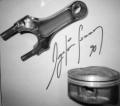Eng Refresh, Health Check, etc 24
by , 20-12-2014 at 01:06 PM (3215 Views)
Another place with high oil pressure that can cause oil seepage.
The oil press sender unit.
Replaced the o-ring and should be fine for many years.
As reported earlier, the IG coil harness holder was broken in the past.
Replaced it with new one and used high temperature spec tape to hold the loom in place.

Initally, we were talking about re-using the CL slave cyl and just replace the master and hose. However, looking at the state of the existing slave cyl and lack of grease at the release fork saddle, decided to replace.
In fact, I always recommend replacing CL Master/Slave/Hose as a set.
New bolts, Urea grease at the release fork saddle and the new CL slave cyl installed.
Carefully installed the dust boot and confirmed that the plunger is seating properly into the saddle.
New thermostat.
The thermostat cover was covered in all sorts of oxidised materials so cleaned it as much as possible.

After cleaning all the corrosion around the coolant hose pipes, new coolant hoses installed.










 Email Blog Entry
Email Blog Entry

